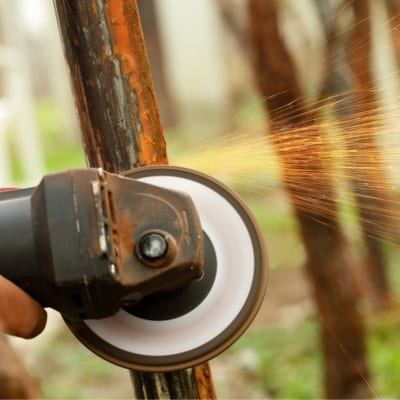Painting metal surfaces can give them a fresh, vibrant look, but what happens when you want to start anew with a clean slate?
Whether you’re revitalizing an old car, restoring a vintage piece of furniture, or fixing a paint job that got wrong, knowing how to remove paint from metal is an essential skill.
You can remove paint from metal using different solutions. These include baking soda and vinegar, a heat gun, a chemical paint stripper, an angle grinder, a paint scraper, and some other ways that I’ll reveal in the article below.
So, stay tuned to learn my proven and effective tips for removing paint from different metal surfaces or components.

Table of Contents
- How To Remove Paint From Metal?
- 1. Baking Soda and Vinegar (Homemade Method)
- 2. Sanding Method (Orbital Sander)
- 3. Heat Gun
- 4. striping paint from metal using a Chemical Paint Stripper
- 5. Angle Grinder
- How can I remove paint from stainless steel?
- Final Words On how to get paint off of metal
- FAQs On how to remove paint off metal easy
- Q. What is the fastest way to strip paint off aluminum?
- Q. Can we use WD 40 for paint removal from metal?
- Q. What removes dried paint from metal?
- Q. Can you use paint remover on Aluminum?
- Q. How to remove paint from metal without scratching?
- Martina Hitchcock
How To Remove Paint From Metal?
As a DIY lover, I have experienced different paint removal techniques that saved me money but also helped me achieve professional-looking results without damaging metal. Let’s discuss the best way to remove paint from metal in detail!
1. Baking Soda and Vinegar (Homemade Method)
Wondering how to remove paint from metal without chemicals? Can we use vinegar to remove paint from metal actually?
Surprisingly, yes! Baking soda mixed with vinegar is a powerful homemade solution for removing paint from metal surfaces. This is applicable to smaller items like door hinges, window frames, etc.
According to the Virginia Department of Health, vinegar has about 4 to 6% acetic acid (source). The acetic acid in vinegar can weaken the clear coat that protects your car’s paint job. This leads to dulling or even peeling that removes paint from metal.
To kickstart this process, create a paste by combining vinegar and baking soda equally to make it a spreadable and thick paste. Thoroughly apply it to the painted metal surface in question, leaving it for 30 minutes. Meanwhile, baking soda paste will work to soften the metal paint, allowing it to be removed easily.
Afterward, use a scrubbing pad or a knife to firmly remove the paint from the surface. You’ll notice the paint lifting and peeling away, revealing the gleaming metal underneath.
2. Sanding Method (Orbital Sander)

Using a sanding process to remove paint from aluminum surface is an effective approach, especially for smaller metal objects or areas where precision is important.
I tried out this paint removal technique using a SKIL 5 Orbital Sander with a 128 Orbital Sander sanding disc. It works like a charm on metal surfaces. I also tried and tested other paint removal sanding tool. Check out our top recommendations.
Start by using rough sandpaper grit, around 80-100, to tackle thick paint layers. If the paint is difficult to remove, you can even use as low as 60 grits. Make sure your sandpaper is firmly attached to the sander, plug it in, and hold it with both hands.
Apply just enough pressure, not too much, and move the sander evenly across the painted area. Then, switch to finer sandpaper, like 120 grit, to smoothen the surface and get rid of any last bits of paint.
3. Heat Gun

You can also use a heat gun to get off paint from metal hardware. This approach is particularly useful for small to medium metal items such as furniture, door handles, or metal art pieces. It is also useful when dealing with multiple paint layers. It works by melting the paint so you can peel it off.
SEEKONE Heat Gun is my personal favorite as it offers a variety of nozzle attachments for different applications. I find it especially versatile for paint removal techniques. Additionally, its precise temperature control allows for more accurate and controlled paint softening.
The first rule to follow when using a heat gun is to ensure your safety. Safety goggles and gloves can help you stay safe from heat and paint splatter.
Set your heat gun to a medium temperature and hold it a few inches away from the painted metal surface. By moving the heat gun up and down throughout the paint surface, you will soften and bubble the paint. As the paint bubbles and softens, use a paint scraper to get the peeled paint clean and scrapped.
4. striping paint from metal using a Chemical Paint Stripper

As per research findings published on ResearchGate, chemical paint strippers containing compounds such as methylene chloride and phenol have seen widespread usage. This is to eliminate polymer coatings from metal surfaces.
Using a paint stripper is a good way to remove spray paint from metal or big items like decks, cars, especially if you have a big metal object covered in spray paint. Your working area must be well-ventilated and free of flammable items that could pose serious hazards.
You can choose a Multi-Strip Paint Remover. I used this stripper to remove paint from my car. And guess what? It removes paint from metal without damaging metal in a single application.
The process is easy-peasy. All you need to do is apply the paint remover with a rag or paintbrush, and let it set for around 30 minutes or more. Paint bubbles will rise from the metal surface.
I scraped the bubbled paint from the surface with a putty knife scraper . It allows for controlled and efficient scraping, dislodging softened paint adequately.
Don’t forget to address intricate areas using nylon brushes. These fine tools can access hard-to-reach spots and ensure a thorough job.
5. Angle Grinder

The angle grinder is a versatile tool that utilizes a rotating disc for tasks like grinding, cutting, or polishing various materials.
To strip paint from metal thoroughly, attach a flap disc to your angle grinder. I recommend the EZARC Flap Discs with 40-grit ratings. These discs are constructed from Zirconia Alumina for optimal performance.
Start your work at a slow speed and increase it as needed for better control.
Maintain a 45-degree angle between the angle grinder and the metal surface while moving the grinder smoothly. As you grind, the paint and rust begin to peel off.
.You can also attach a wire brush to clear away any loose debris during the process. After successfully removing the paint, clean the metal surface with a solvent or degreaser to eliminate any debris.
How can I remove paint from stainless steel?
Turpentine is a useful solvent for eliminating dried paint stains. Dampen a clean, soft cloth with turpentine, then gently rub the stain. The rubbing motion will effectively loosen the paint stain, allowing for its removal with some exertion.
Alternatively, vinegar can be employed. Apply vinegar onto a cloth and wipe it across the painted area. The vinegar will initiate paint dissolution, significantly easing its elimination. After the paint vanishes, ensure thorough rinsing of the area with water to eliminate any traces of vinegar.
Final Words On how to get paint off of metal
Learning how to remove paint from metal surfaces is useful skill for DIYers or restorers. When it comes to revitalizing metal objects, whether it’s an old car, a cherished piece of furniture, or any metal component that needs a fresh start, the above discussed tactics are quite helpful in the paint removal process.
By mastering techniques for removing spray paint from metal, you save money but also gain the satisfaction of achieving refined results. This is done while preserving the integrity of the underlying metal.
FAQs On how to remove paint off metal easy
Q. What is the fastest way to strip paint off aluminum?
The most rapid and cost-effective practice for removing paint from aluminum is plastic media blasting, although aircraft strippers can be considered a second-best alternative.
Q. Can we use WD 40 for paint removal from metal?
WD-40 Multi-Use Product provides a seamless way to get paint off metal, including your car’s delicate metallic finish. Whether you’re working with fresh, wet paint or stubborn, old stains, WD-40 delivers efficient results with minimal effort. This is all while protecting precious metal paint.
Q. What removes dried paint from metal?
Metal surfaces can be cleaned with ammonia or acetone. Ammonia raises the pH level, weakening the bond between paint and metal, allowing peeling. Acetone, on the other hand, is a potent solvent that breaks down paint, making it easier to remove from metal surfaces.
Q. Can you use paint remover on Aluminum?
You can use a paint remover on aluminum surfaces. However, it’s safe to ensure the product is explicitly designed for use on aluminum surfaces to prevent potential issues.
Q. How to remove paint from metal without scratching?
To remove paint from metal without scratching, create a gentle homemade paint remover for metal by mixing baking soda and vinegar. Apply the paste to the painted area, let it sit for 15-20 minutes, then gently scrape off the softened paint using a plastic scraper or a soft cloth. Repeat if necessary, and finish by cleaning the metal area with a rough cloth.

Martina Hitchcock
Martina Hitchcock is a versatile author with expertise in different fields. As a paint sprayer expert, she has in-depth knowledge of paint spraying techniques, tools, and equipment. Martina is also an experienced home remodeler who has worked on various projects, including kitchen and bathroom renovations, flooring installations, and room additions. Her knowledge of home improvement and remodeling is extensive, and she enjoys sharing her insights and tips with readers. You can follow her on Facebook.


